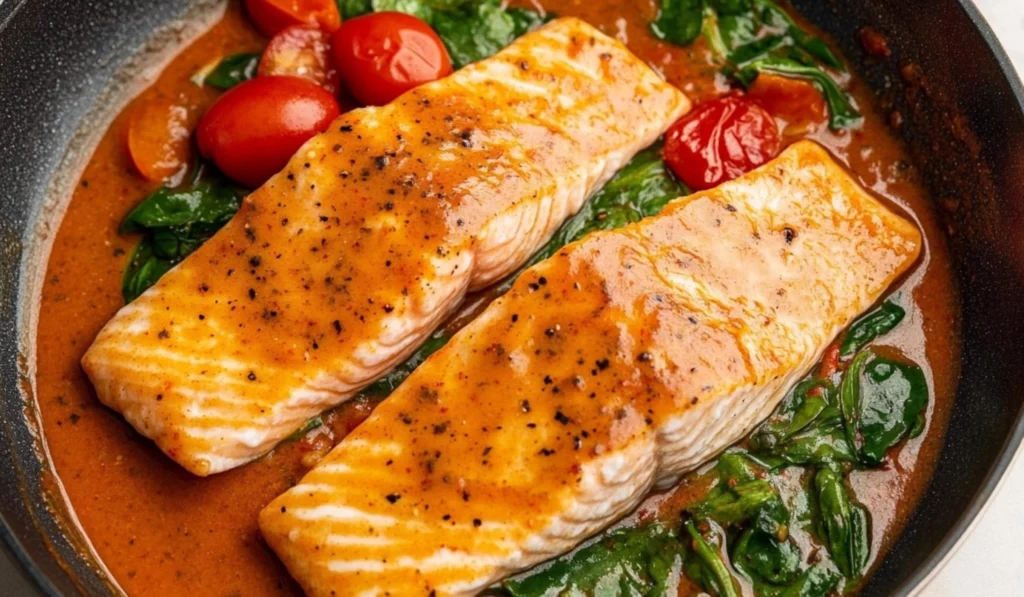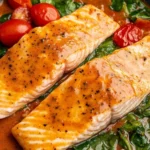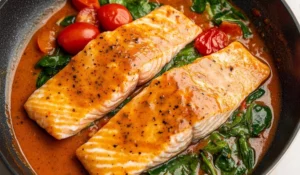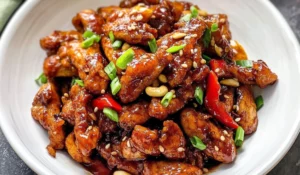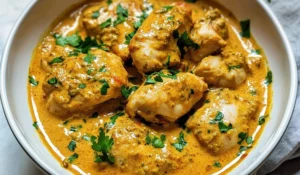There’s a certain elegance to a perfectly cooked salmon fillet, its tender flesh flaking apart under a creamy, flavorful sauce. It’s a dish that seems to whisper “special occasion,” yet it’s surprisingly simple to create in your own kitchen, even if you’re just starting your culinary journey. I remember the first time I attempted to cook salmon with a creamy sauce. I was intimidated, thinking it was a dish reserved for experienced cooks. But the simplicity of this Creamy Roasted Red Pepper Salmon recipe proved me wrong. The vibrant red pepper sauce, the tender salmon, and the overall ease of preparation made it an instant favorite.
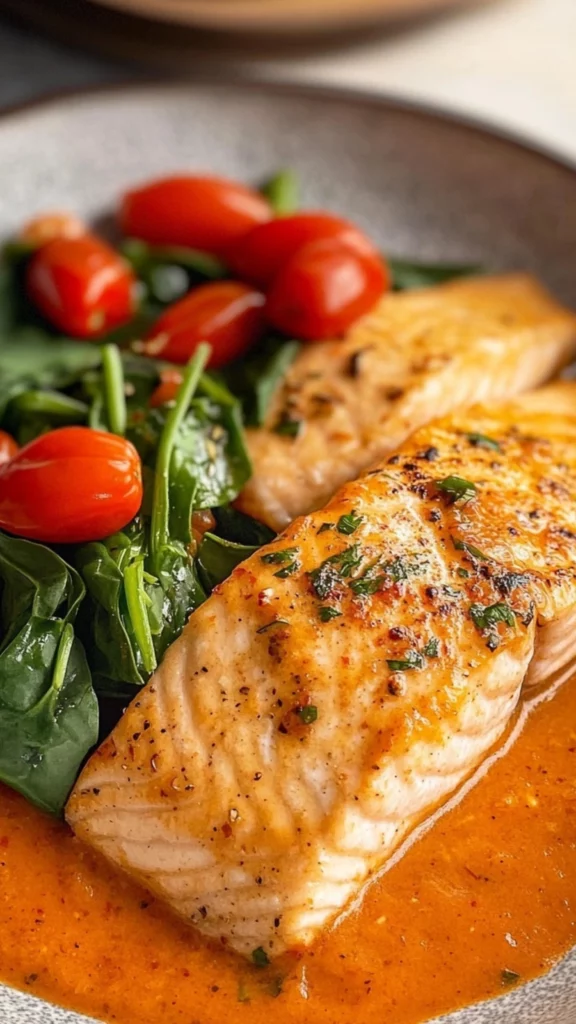
Creamy Roasted Red Pepper Salmon: A Decadent Delight for Beginners
Enjoy flaky salmon with a rich, creamy roasted red pepper sauce. This simple recipe is perfect for beginners and delivers a delicious, healthy meal. Serve with rice, pasta, or vegetables for a complete dinner.
- Prep Time: 20 minutes
- Cook Time: 20 minutes
- Total Time: 40 minutes
- Yield: 4–6 servings 1x
- Category: Main Course, Dinner
- Method: Stovetop
- Cuisine: Mediterranean Inspired, Fusion
- Diet: Gluten Free
Ingredients
- 2 lbs salmon, cut into individual portions
- 2 Tbsp avocado oil
- 1/2 tsp sea salt, to taste
- 1 tsp garlic powder
- ½ tsp paprika
- Roasted Red Pepper Sauce:
- 1 Tbsp avocado oil
- 1 cup yellow onion, chopped
- 5 large cloves garlic, minced
- 1 (16-oz) jar roasted red peppers, drained
- 1 (15-oz) can full-fat coconut milk
- 1 tsp sea salt, to taste
- 1 cup cherry tomatoes, optional
- 5 ounces baby spinach, optional
Instructions
Make the Roasted Red Pepper Sauce:
- Sauté Onions and Garlic: Heat one tablespoon of avocado oil in a large skillet over medium-high heat. Add the chopped onion and sauté, stirring occasionally, until the onion has softened, about 5 minutes. Add in the minced garlic and sauté for another 2-3 minutes, or until the garlic is fragrant. Sautéing the onions and garlic releases their aromatic compounds, creating a flavorful base for the sauce.
- Blend the Sauce: Transfer the sautéed onion and garlic mixture to a high-powered blender or food processor. Add the drained roasted red peppers, coconut milk, and sea salt. Blend until the sauce is completely creamy and smooth. Using a high-powered blender or food processor ensures a uniform and velvety texture.
- Set Aside: Set the skillet aside to use for cooking the salmon.
Cook the Salmon:
- Heat the Skillet: Heat two tablespoons of avocado oil in the same large skillet over medium-high heat. Allow the skillet to heat up for a few minutes until it is sizzling hot, aiming for 400 to 500 degrees Fahrenheit. Using a hot skillet ensures that the salmon sears properly and develops a crispy crust.
- Season the Salmon: Season the salmon fillets with sea salt, garlic powder, and paprika. Seasoning the salmon before cooking enhances its flavor and ensures it is seasoned throughout.
- Sear the Salmon: Carefully place the salmon fillets skin side up (flesh-side down) on the hot skillet. Cook salmon for 6 minutes on the flesh side. Use a sturdy spatula to carefully flip the salmon and cook for 4 minutes on the salmon skin side, or cook to your desired level of doneness. Searing the salmon on the flesh side first creates a crispy crust and ensures even cooking.
- Check for Doneness: Salmon is considered fully cooked once it reaches an internal temperature of 145 degrees Fahrenheit. However, many people prefer the texture of salmon when it reaches 125 degrees Fahrenheit, which results in a softer, juicier texture. Use a meat thermometer to check the internal temperature, inserting it into the thickest part of the fillet.
- Rest the Salmon: Transfer the pan-seared salmon to a plate and allow it to rest for 10 minutes while you finish making the sauce. Resting the salmon allows the juices to redistribute, resulting in a more tender and flavorful fish.
Put it All Together:
- Heat the Sauce: Pour the roasted red pepper sauce into a skillet or saucepan. If you’re using the same skillet you used to cook the salmon, allow it to cool down slightly before adding the sauce. Heat over medium heat and bring the sauce to a gentle bubble. Heating the sauce ensures it is warm and ready to serve.
- Add Tomatoes and Spinach (Optional): Add in the cherry tomatoes and spinach, if using, and continue cooking and stirring just until the spinach has wilted, about 2 to 3 minutes. Adding the tomatoes and spinach adds a touch of freshness and color to the sauce.
- Serve: Transfer the salmon to bowls or plates with a lip and pour your desired amount of roasted red pepper sauce over the salmon. Serve salmon with steamed rice, mashed potatoes, risotto, couscous, pasta noodles, or anything that can soak up the delicious sauce.
Notes
- Use a meat thermometer for perfect salmon.
- Don’t overcrowd the skillet.
- Adjust sauce thickness with coconut milk.
- Rest salmon before serving.
This recipe is an ideal starting point for beginner cooks. It’s designed to be straightforward, requiring minimal kitchen skills and readily available ingredients. The process is quick, making it perfect for busy weeknights, and it offers a healthy dose of omega-3 fatty acids from the salmon, along with vitamins and antioxidants from the roasted red pepper sauce and optional vegetables. It’s a versatile dish that can be paired with a variety of sides, allowing you to create a complete and satisfying meal that feels both special and approachable.
Ingredients and Preparation: The Building Blocks of Flavor
This recipe relies on a harmonious blend of simple, easily accessible ingredients that, when combined, create a symphony of creamy, savory, and subtly sweet flavors. Here’s a detailed breakdown with added tips and tricks to ensure culinary success:
For the Salmon:
- Salmon: 2 lbs, cut into individual portions. Salmon is the centerpiece of this dish, providing a rich source of protein and omega-3 fatty acids. Opt for fresh salmon fillets with firm flesh and a vibrant color. You can choose skin-on or skinless salmon based on your personal preference. Ensure the salmon is properly portioned for even cooking.
- Avocado Oil: 2 Tbsp. Avocado oil boasts a high smoke point, making it ideal for searing salmon. You can also substitute with olive oil or another high-heat cooking oil if needed.
- Sea Salt: 1/2 tsp, to taste. Sea salt enhances the inherent flavors of the salmon and complements the creamy sauce. Use kosher salt or regular table salt as suitable alternatives.
- Garlic Powder: 1 tsp. Garlic powder infuses the salmon with a savory and aromatic flavor. Select a good quality garlic powder for the most pronounced and authentic taste.
- Paprika: ½ tsp. Paprika contributes a subtle sweetness and smokiness, enriching the flavor profile of the salmon. You can use sweet paprika or smoked paprika, depending on your desired level of smokiness.
For the Roasted Red Pepper Sauce:
- Avocado Oil: 1 Tbsp. Avocado oil is utilized to sauté the onions and garlic, creating a flavorful base for the sauce.
- Yellow Onion: 1 cup, chopped. Yellow onion adds a sweet and savory foundation to the sauce. Chop the onion into small, uniform pieces to ensure even cooking.
- Garlic Cloves: 5 large, minced. Fresh garlic imparts a pungent and aromatic flavor, enhancing the overall taste of the sauce. Use fresh garlic for the most intense and authentic flavor.
- Roasted Red Peppers: 1 (16-oz) jar, drained. Roasted red peppers contribute a sweet and smoky dimension to the sauce. Thoroughly drain the peppers to remove excess liquid and prevent a watery sauce.
- Full-Fat Coconut Milk: 1 (15-oz) can. Full-fat coconut milk provides a creamy and rich texture to the sauce. You can use light coconut milk for a lighter option, but the sauce will be less creamy.
- Sea Salt: 1 tsp, to taste. Sea salt balances the flavors of the sauce and enhances its overall taste.
- Cherry Tomatoes: 1 cup, optional. Cherry tomatoes add a touch of sweetness and acidity, complementing the creamy sauce. You can use other types of tomatoes, such as grape tomatoes or diced tomatoes.
- Baby Spinach: 5 ounces, optional. Baby spinach contributes a vibrant color and a boost of nutrients to the sauce. You can use other types of greens, such as kale or Swiss chard.
Alternative Ingredient Suggestions:
- Salmon: For a change of pace, you can use other types of fish, such as cod, halibut, or sea bass. Adjust the cooking time accordingly to ensure proper doneness.
- Avocado Oil: If avocado oil is unavailable, you can use olive oil, grapeseed oil, or another high-heat cooking oil.
- Roasted Red Peppers: For a more intense flavor, you can roast your own red peppers. Simply roast whole red peppers in the oven until their skin is charred, then peel and seed them.
- Coconut Milk: For a dairy-based alternative, you can use heavy cream or half-and-half.
- Vegetables: Feel free to experiment with different vegetables in the sauce. Mushrooms, bell peppers, and zucchini are excellent additions.
Step-by-Step Instructions: Creating Your Creamy Roasted Red Pepper Salmon Masterpiece
Make the Roasted Red Pepper Sauce:
- Sauté Onions and Garlic: Heat one tablespoon of avocado oil in a large skillet over medium-high heat. Add the chopped onion and sauté, stirring occasionally, until the onion has softened, about 5 minutes. Add in the minced garlic and sauté for another 2-3 minutes, or until the garlic is fragrant. Sautéing the onions and garlic releases their aromatic compounds, creating a flavorful base for the sauce.
- Blend the Sauce: Transfer the sautéed onion and garlic mixture to a high-powered blender or food processor. Add the drained roasted red peppers, coconut milk, and sea salt. Blend until the sauce is completely creamy and smooth. Using a high-powered blender or food processor ensures a uniform and velvety texture.
- Set Aside: Set the skillet aside to use for cooking the salmon.
Cook the Salmon:
- Heat the Skillet: Heat two tablespoons of avocado oil in the same large skillet over medium-high heat. Allow the skillet to heat up for a few minutes until it is sizzling hot, aiming for 400 to 500 degrees Fahrenheit. Using a hot skillet ensures that the salmon sears properly and develops a crispy crust.
- Season the Salmon: Season the salmon fillets with sea salt, garlic powder, and paprika. Seasoning the salmon before cooking enhances its flavor and ensures it is seasoned throughout.
- Sear the Salmon: Carefully place the salmon fillets skin side up (flesh-side down) on the hot skillet. Cook salmon for 6 minutes on the flesh side. Use a sturdy spatula to carefully flip the salmon and cook for 4 minutes on the salmon skin side, or cook to your desired level of doneness. Searing the salmon on the flesh side first creates a crispy crust and ensures even cooking.
- Check for Doneness: Salmon is considered fully cooked once it reaches an internal temperature of 145 degrees Fahrenheit. However, many people prefer the texture of salmon when it reaches 125 degrees Fahrenheit, which results in a softer, juicier texture. Use a meat thermometer to check the internal temperature, inserting it into the thickest part of the fillet.
- Rest the Salmon: Transfer the pan-seared salmon to a plate and allow it to rest for 10 minutes while you finish making the sauce. Resting the salmon allows the juices to redistribute, resulting in a more tender and flavorful fish.
Put it All Together:
- Heat the Sauce: Pour the roasted red pepper sauce into a skillet or saucepan. If you’re using the same skillet you used to cook the salmon, allow it to cool down slightly before adding the sauce. Heat over medium heat and bring the sauce to a gentle bubble. Heating the sauce ensures it is warm and ready to serve.
- Add Tomatoes and Spinach (Optional): Add in the cherry tomatoes and spinach, if using, and continue cooking and stirring just until the spinach has wilted, about 2 to 3 minutes. Adding the tomatoes and spinach adds a touch of freshness and color to the sauce.
- Serve: Transfer the salmon to bowls or plates with a lip and pour your desired amount of roasted red pepper sauce over the salmon. Serve salmon with steamed rice, mashed potatoes, risotto, couscous, pasta noodles, or anything that can soak up the delicious sauce.
Beginner Tips and Notes: Mastering the Art of Creamy Roasted Red Pepper Salmon
- Troubleshooting: Sauce is too thin: If the sauce is too thin, simmer it for a few more minutes to reduce it and thicken it.
- Troubleshooting: Sauce is too thick: If the sauce is too thick, add a little more coconut milk or water to thin it out to your desired consistency.
- Troubleshooting: Salmon is overcooked: If your salmon is overcooked, it will be dry and tough. Use a meat thermometer to check the internal temperature and avoid overcooking.
- Efficient Prep: Make the roasted red pepper sauce ahead of time and store it in the refrigerator for up to 3 days. This saves time on the day you plan to cook the salmon.
- Skillet Size: Use a large skillet to ensure the salmon cooks evenly.
Serving Suggestions: Completing Your Creamy Roasted Red Pepper Salmon Feast
This Creamy Roasted Red Pepper Salmon is delicious on its own, but it can be even better when served with a variety of sides. Here are some ideas:
- Rice: Steamed rice, brown rice, or cauliflower rice are excellent choices for soaking up the creamy sauce.
- Mashed Potatoes: Creamy mashed potatoes provide a comforting and starchy base for the salmon.
- Risotto: A creamy risotto with Parmesan cheese complements the richness of the salmon.
- Couscous: Fluffy couscous adds a light and delicate side dish.
- Pasta Noodles: Pasta noodles, such as linguine or fettuccine, are perfect for twirling in the creamy sauce.
Storage Tips for Leftovers:
Store leftover Creamy Roasted Red Pepper Salmon in an airtight container in the refrigerator for up to 3 days. Reheat in a skillet over medium-low heat or in the microwave until heated through. If reheating in the microwave, cover the salmon and sauce with a paper towel to prevent splattering. You can also freeze leftover salmon for up to 3 months. To freeze, let the salmon and sauce cool completely before transferring them to a freezer-safe container. Thaw overnight in the refrigerator before reheating.
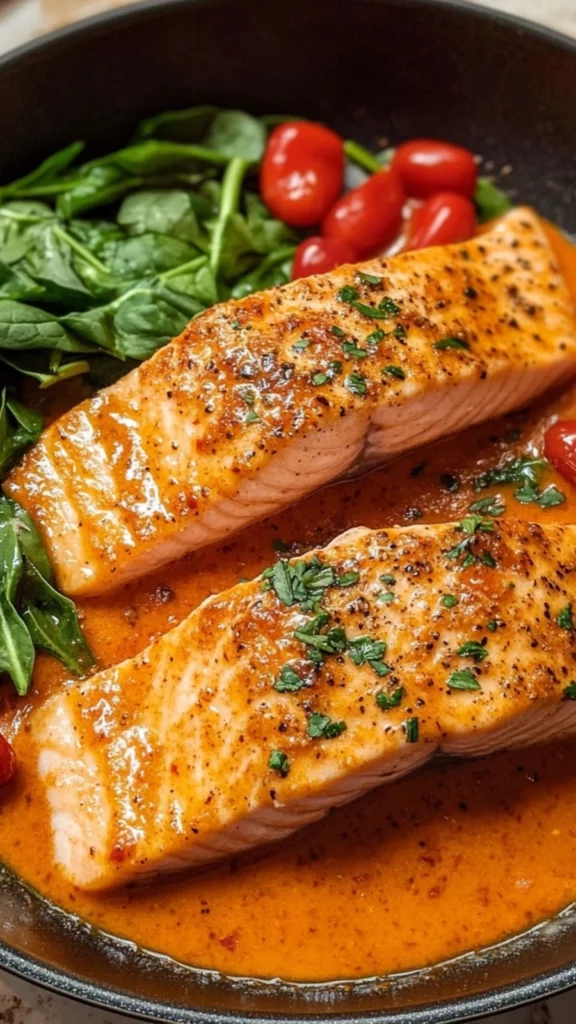
Conclusion: Share Your Culinary Creations!
This Creamy Roasted Red Pepper Salmon is a fantastic and easy way to enjoy a delicious and healthy meal. I highly encourage you to try this recipe out and let me know how it turns out in the comments below! I genuinely love hearing about your cooking adventures and any modifications you make to the recipe. Did you try a different type of fish or vegetable? Did you add any other seasonings? Share your tips, tricks, and photos with other readers! Your feedback is invaluable and helps others who are trying the recipe for the first time. Let us know what sides you enjoyed most with the salmon. Did you serve it with rice, mashed potatoes, or roasted vegetables? Share your photos and tag me on social media so I can see your Creamy Roasted Red Pepper Salmon masterpieces! Use #RoastedRedPepperSalmon and #EasySalmonRecipes so I can find your creations. I also love seeing your variations on Instagram stories – tag me so I can see what you’re cooking up in your kitchen! Happy cooking, and I can’t wait to hear from you!
